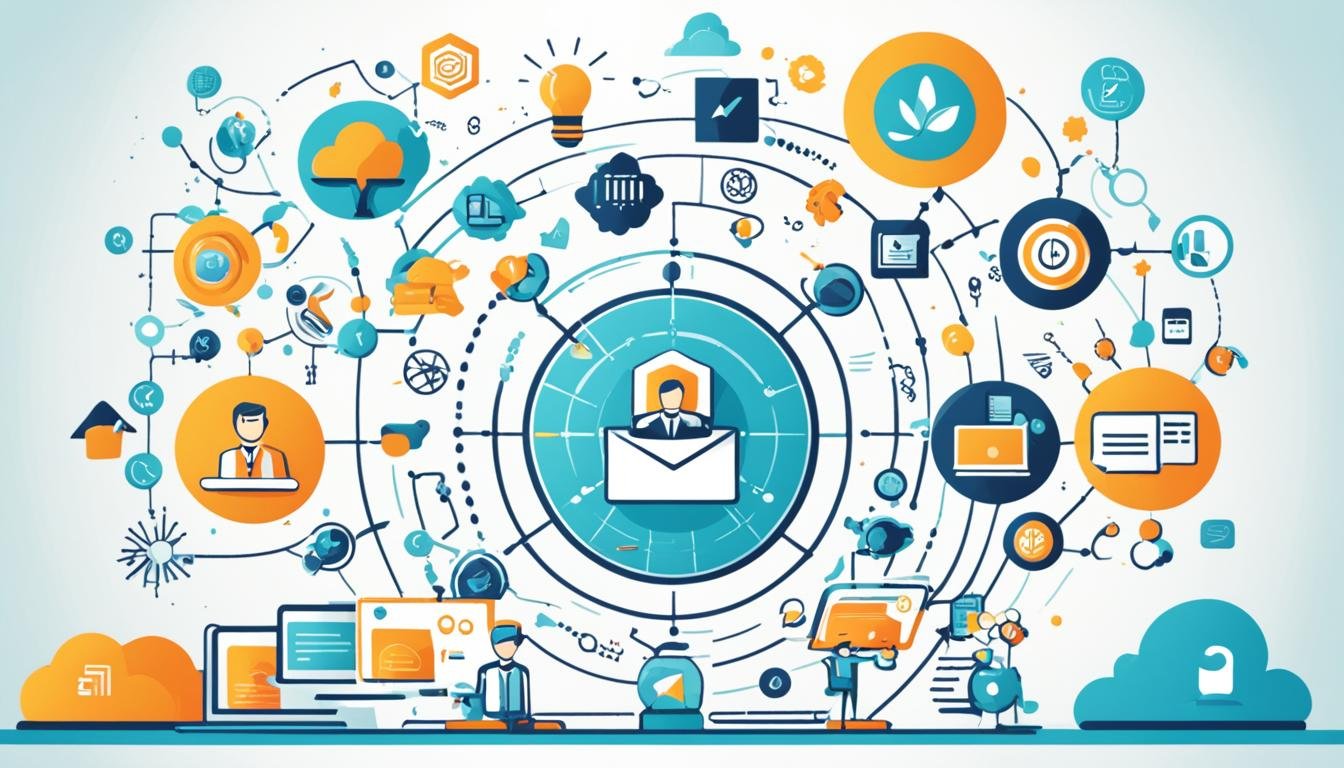Digitalization in Marketing: Transforming Strategies.
Did you know over 90% of companies now use digital marketing? This big change in the last ten years shows how digital has changed how businesses reach out to customers. As tech in ads keeps getting better, marketers need to use these changes to better engage with customers and grow their businesses.
With three billion users on Facebook, social media’s huge reach is clear. This has made ad spending on these platforms soar. Companies are now seeing the need to update their strategies to keep up with digital trends, like SEO to get noticed online.
Mobile devices have changed how people act, making marketers adjust their ads for smaller screens and quick attention. Using data in marketing lets brands target specific groups and make content that hits home. As companies move through this digital world, they must keep their strategies fresh to increase brand visibility and drive more sales with engaging content.
In today’s marketing world, going digital means stepping up and aiming for the best. By checking out current marketing tools and understanding what customers go through, companies can make their strategies work better. This approach not only makes for a smoother customer experience but also gets them ready for the digital world’s fast pace.
Key Takeaways
- Digitalization has transformed marketing strategies in the past decade.
- Social media platforms like Facebook enhance advertising reach globally.
- Effective SEO is crucial for visibility and adapting to changing user behavior.
- Data-driven marketing enables targeted and personalized advertising.
- Ongoing adaptation to digital trends is essential for business competitiveness.
- Companies must optimize digital tools for a cohesive customer journey.
- Continuous evolution is necessary to thrive in the digital marketing landscape.
Understanding Digital Transformation in Marketing
Digital transformation in marketing is a big change for businesses. It means using digital tech in every part of the business. This helps companies connect better with customers and offer more value. Using good internet marketing techniques is key to success in this new digital world.
Definition and Scope of Digital Transformation
Digital transformation means using digital tech in all parts of a business. It aims to make things more efficient, improve customer experiences, and encourage innovation. Companies use tech like artificial intelligence and cloud computing to drive change. They must update old ways and adopt new digital strategies to compete.
The Importance of Digital Transformation for Businesses
Every business needs to focus on digital transformation today. With more online shopping and contactless payments, being digital is crucial. Companies that invest in digital do better at engaging customers and standing out from rivals. For example, Nike has grown its online presence and revenue by going digital. Starbucks uses digital tools to improve its services and customer care.
| Business Aspect | Traditional Approach | Digital Transformation |
|---|---|---|
| Customer Engagement | Limited interaction, manual processes | Personalized experiences, automated engagement |
| Operational Efficiency | Time-consuming manual tasks | Streamlined processes, real-time analytics |
| Data Utilization | Minimal data analysis | Data-driven decision making, continuous monitoring |
| Market Reach | Physical advertising only | Multi-channel internet marketing techniques |
It’s important to set clear goals and track progress with KPIs when going digital. By fully using digital tech in marketing, businesses can improve how they work and keep up with what customers want.
Data-Driven Marketing: The New Paradigm
Data-driven marketing changes the game by using insights from what customers do and like. This makes marketing more effective and personal. Companies that use data see a big boost in their return on investment. For example, Certain saw a 10-20% increase in ROI with data-driven strategies. eMarketer magazine also found that 40% of brands are planning to increase their budgets for these methods.
Benefits of Data Utilization in Marketing Strategies
Using data has many benefits for marketing. Companies that customize their approach hit their sales goals 83% of the time, says a Monetate survey. The main advantages are:
- Tailored Content Delivery: Personalized messages get more people involved.
- Better Customer Segmentation: Teams can make campaigns that really speak to their audience.
- Actionable Insights: With data, campaigns can be constantly improved, leading to smarter choices.
Small businesses, like a smoothie shop making $300-$500 a day, gain a lot from marketing automation. This helps them connect with customers based on past interactions.
Implementing Data Analytics for Improved Customer Insights
To make the most of data-driven marketing, using data analytics well is key. Companies should collect important customer data in various ways. Here are some examples:
| Data Fields | Examples |
|---|---|
| Communication Channels | Email, SMS number, Phone Number |
| Last Visit Data | Last Visit Time, Visit Revenue, Product/Service Purchased |
| Demographic Information | Zip code, Gender, Birthday |
| Profile Information | Name, Photo |
Offering something in return can encourage customers to share their info. For instance, a “Free Drink” for an email or “10% Off” for signing up works well. After getting this data, automation is key in reaching out to customers. For example, a birthday text with a discount or a message after 21 days can bring customers back.
Customer-Centric Approach in Digitalization
Today, brands are focusing more on what customers need and want. This approach makes digital branding strategies more effective. By engaging with customers on a personal level, brands build stronger relationships. This leads to more loyalty and satisfaction.
Prioritizing Customer Engagement
Getting customers involved is key for businesses to connect with them. Studies show 89% of companies are going digital or plan to. This shows how important it is for brands to improve how they talk to customers.
Customers who feel connected are more likely to come back. They also help spread the word about the brand.
- Custom experiences foster customer loyalty.
- High customer engagement enhances retention rates.
- Understanding customer needs boosts average order value.
- Identifying frustrations leads to tailored service improvements.
Mapping the Customer Journey Through Digital Tools
Knowing the customer journey is key to improving engagement. Tools help see how customers move through different platforms. This is crucial in today’s digital world.
By mapping this journey, companies can make experiences more personal. This makes customers happier overall.
| Customer Journey Aspect | Impact of Digital Tools | Customer Benefits |
|---|---|---|
| Segmenting Audiences | Improved targeting through data analytics | Relevance of offerings to individuals |
| Identifying Struggles | Use of CRM software for tracking | Customized solutions for pain points |
| Personalized Experiences | Digital branding initiatives and campaigns | Increased satisfaction and loyalty |
Companies that focus on customers gain a lasting edge. They meet customer needs and build strong relationships. Through good digital branding, companies can make their customers’ journeys better. This leads to more value for customers and a stronger brand connection.
Digitalization in Marketing: Transforming Strategies
Digitalization changes the game for brands in marketing. It lets companies use technology to change old marketing ways. Now, they use internet marketing techniques to better engage with customers and get better results.
This shift helps marketers create new digital marketing strategies. These strategies connect with customers in deep ways, building loyalty over time.
How Technology Redefines Marketing Practices
Businesses are quickly adapting to the digital world. They use many tools to focus on what customers want. Data analytics is key, helping marketers understand what customers like and dislike.
By looking at feedback and social media, brands can make choices that hit the mark. Marketing technologies like CRM systems and automation tools help too. They make sure brands send the same message everywhere.
Shifting from Traditional to Digital Marketing Strategies
Switching to digital marketing has big advantages. Companies can quickly adapt to new trends and what customers want. They focus on content marketing to build strong relationships and increase sales.
Using paid ads and social media, brands get more visibility and interaction. Technology helps optimize these strategies to meet customer needs.
The Role of Artificial Intelligence in Marketing
Artificial intelligence is changing how we market today. It brings new tools that make marketing easier and improve how we connect with customers. By using AI, companies can make their marketing better in many ways, like making things run smoother and talking to customers in a more personal way.
AI Applications for Marketing Automation
AI makes marketing automation possible. It uses machine learning and predictive analytics to understand huge amounts of data and guess what customers might do next. This helps companies work better and faster. Customers get quick and personalized messages that make them feel valued. Some key uses are:
- Chatbots for quick customer service
- Predictive analytics for spotting trends
- Content generation tools for focused marketing
Enhancing Customer Experience with AI-Powered Tools
AI is key to making customers happier. Tools that use natural language processing (NLP) help companies understand and talk back to customer questions, keeping them engaged. AI also watches how people feel about a brand in real-time, letting companies fix issues fast. This helps keep customers happy and loyal. The big wins are:
- Marketing that feels made just for you
- Automated content making a bigger impact
- Deep analytics for smart business moves
Omnichannel Integration for Maximum Reach
Omnichannel marketing helps businesses give customers a smooth experience across different platforms. This approach makes sure the brand is seen everywhere and sends out the same message. It builds trust and makes customers recognize the brand more.
Benefits of a Unified Marketing Strategy
A unified marketing strategy has many benefits:
- Increased engagement: Omnichannel customers shop 1.7 times more than those using a single channel, often leading to higher spending.
- Personalization: About 80 percent of US adults desire personalized experiences from retailers that utilize multiple touchpoints.
- Operational efficiency: Streamlined processes contribute to better data integration and reduced redundancy in marketing efforts.
- Enhanced trust: Consistent interactions across channels foster a sense of predictability among customers.
Integrating Multiple Channels for a Seamless Experience
Using different channels like social media and email marketing together makes a complete approach. This keeps customers interested at every step. Here are some key facts showing the effect:
| Channel Switching Behavior | Impact on Purchases |
|---|---|
| More than half of B2C customers engage with three to five channels | Increased likelihood of making a purchase |
| On average, customers switch nearly six times when making online reservations | Enhanced customer experience |
| Omnichannel campaigns have a purchase rate 287% higher than single-channel campaigns | Major revenue opportunities |
As people’s shopping habits change, businesses need to use omnichannel marketing to stay relevant. By making the most of every contact, brands can boost engagement and satisfaction. This matches up with how people shop today.
Content Marketing in a Digital World
In today’s digital world, content marketing is key for brands to connect with different people. By sharing valuable content, brands can become leaders in their field and draw in more visitors. Content marketing helps build strong relationships and keep customers coming back.
Creating Engaging Content for Diverse Audiences
To make content that hits the mark, you need to know who you’re talking to. Using storytelling, infographics, and educational pieces can make your content stand out. Here are some tips to grab your audience’s attention:
- Make sure your content is high-quality and offers real value.
- Use storytelling to touch people’s hearts.
- Add visuals to help people understand better.
- Keep your content fresh and up-to-date.
Putting effort into your content strategy pays off. Most marketers, 90%, keep investing in content marketing. And 66% plan to spend more. This smart move helps brands reach and connect with their audience better.
Using SEO to Drive Traffic and Engagement
SEO is a must for getting your content seen and shared. When you optimize your content with the right keywords, you climb up in search rankings. Posting new, relevant content often tells search engines you’re active. SEO in content marketing brings big benefits:
- More people find your content through keywords.
- You get more visibility on search engines.
- People engage more with your valuable content.
- Trust and credibility grow with your audience.
Building a connection with your audience builds trust and gets them talking about you. Overcoming content marketing hurdles, like getting leads and coming up with ideas, helps. Keep a content ideas journal and test your content to see what works. With a good plan, content marketing can really pay off, bringing in leads and boosting sales.
| Statistic | Value |
|---|---|
| Marketers continuing investment in content marketing | 90% |
| Businesses planning to increase content marketing budget | 66% |
| Cost-effectiveness of content marketing | High |
| Content generating leads and building sales | Effective |
Trends in Digital Marketing: What to Watch For
Staying on top of digital marketing trends helps businesses lead in a tough market. New tech changes how brands talk to customers and make experiences. Let’s look at these changes and how they affect customer behavior.
Emerging Technologies Shaping Digital Marketing
Today’s market is changing fast, thanks to emerging technologies. These new tools are changing how marketers connect with their audience. Here are some key ones:
- Metaverse marketing: This lets users explore 3D worlds and feel like they’re part of the action.
- Voice search enhancements: Smartphones and assistants like Alexa are getting better at understanding what we say.
- Social commerce: Now, businesses can track important metrics like sales and customer interaction easily.
- Programmatic advertising: This makes placing ads automatic, saving time and money.
- Conversational marketing: Chatbots and messaging boost customer service and happiness.
- Automated emailing: Sending emails that feel personal, based on how people react to them.
- Influencer marketing: Using influencers to reach audiences more effectively.
Brands like Nike are using AI to make things more personal, changing the game.
Future Trends in Customer Behavior and Expectations
Knowing how customer behavior is changing is key for good marketing. Today, people want things that feel made just for them. This shows a big trend where:
- 76% of consumers like brands that share their values.
- More people care about the planet, pushing brands to be green.
- With over 29 billion IoT devices by 2027, we’ll have more data to make marketing better.
- AR tech can boost online sales by making shopping more fun and engaging.
Adapting to these digital marketing trends helps companies make big impacts in the future.
Challenges of Embracing Digitalization
Embracing digitalization opens up huge opportunities, but it comes with big challenges. It’s key to know the challenges of digitalization to make it work. Many barriers to digital transformation can slow things down, like cultural issues, not having the right skills, and fitting new tech with old systems.
Potential Barriers to Effective Digital Transformation
There are a few big hurdles on the path to digital transformation:
- Cultural Resistance: Many employees might not want to change, worried about losing their jobs or facing big changes.
- Talent Shortages: A big issue is not having enough skilled people, with 54% of companies struggling to meet their digital goals.
- Legacy Systems Integration: Old systems can make it hard to add new tech, leading to less efficiency.
- Data Security Concerns: Keeping sensitive info safe is tough, especially with more cyber threats around.
- Cost Management: It’s tough for companies to spend on new tech without going over budget.
- Regulatory Compliance: Keeping up with ever-changing rules is a big challenge for businesses.
Strategies for Overcoming Digitalization Challenges
Using smart strategies can help beat these challenges and make digital transformation work:
- Invest in Change Management: Companies that plan for change well are six times more likely to hit their goals.
- Focus on Training: Create training to boost employee skills and fill skill gaps.
- Embrace a Culture of Adaptability: Create a work culture that welcomes change and flexibility.
- Prioritize Data Security: Use strong cybersecurity to keep customer data safe and build trust.
- Promote Continuous Learning: Encourage learning about new tech and methods to stay ahead in the market.
By tackling the barriers to digital transformation, companies can better overcome hurdles. This boosts their chances of doing well and staying strong in the digital world.
Conclusion
Digitalization has changed how businesses work and connect with customers. About 47% of companies don’t have a clear digital marketing plan but still use digital tools. It shows that adapting to digital changes is key for growth.
Brands need to keep up with changing customer needs. Using data and focusing on customers can make their experiences better and strengthen their market position. It’s important to invest in digital marketing always, as not doing so can lead to losing customers to competitors.
Using new digital marketing methods like SEO and PPC can bring big returns. Brands that combine their digital efforts and understand what customers want can make strong offers. This approach helps attract customers, increase engagement, and build loyalty. In today’s digital world, being quick to adapt is crucial for success in marketing.
Source Links
- Digital Marketing Transformation: Adapting Strategies
- What is a Digital Transformation in Marketing?
- What is digital transformation?
- Digital strategy vs. digital transformation: What’s the difference?
- Council Post: What Does Digital Transformation Mean For Marketers?
- How Data-Driven Culture Will Revolutionize Digital Marketing
- The New Age of Data-Driven Marketing – CityGro by Patch
- Customer-Centric Approach in Creating Digital Experiences
- Mastering Customer-Centric Digital Marketing
- Digital transformation and its impact on marketing strategies
- Digital Transformation in Marketing | Ficode
- The role of artificial intelligence in marketing
- The Role of Artificial Intelligence in Digital Marketing
- What is omnichannel marketing?
- Omnichannel Strategy: How to Create an Integrated Customer E
- Omnichannel marketing 101: What it is and why it matters | Zapier
- Council Post: The Impact Of Content In Digital Marketing
- The Importance of Content Marketing in the Digital Age
- Article Detail – International Journal of Advanced Research
- The Future Of Digital Marketing: Emerging Trends To Watch
- Digital Trends 2024: Exploring Key Digital Marketing Innovations
- 11 Critical Digital Transformation Challenges to Overcome (2023) | Whatfix
- The Impact Of Digital Transformation On Business Models: Opportunities And Challenges
- 10 Digital Transformation Challenges to Overcome
- 10 reasons you need a digital marketing strategy in 2024
- Importance of Digital Marketing: 8 Reasons Why Digital Marketing Is Important







